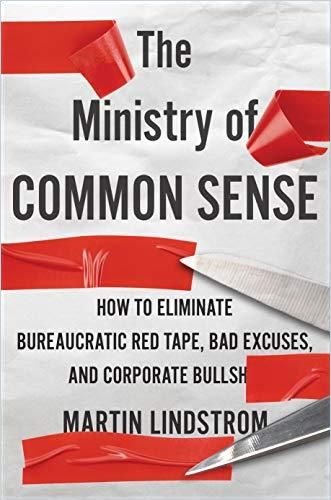Best-selling author and common sense consultant Martin Lindstrom explains how to rid your company of inane rules and managerial stupidity.

Avoid Stupidity
Global consultant and Wall Street Journal bestseller Martin Lindstrom knows corporate foibles from the inside. Here, he recounts a few of the business world’s most ludicrous bureaucratic rules. His entertaining jaunt through inanity may lead you to consider what idiocies your company exhibits and why. Lindstrom’s useful, fun manual will inspire executives and staff members to try to reduce the level of stupidity in their organization’s actions and policies.
Choosing this as its Book of the Month, The Financial Times said, “Anyone who has ever worked in a big corporate structure will be nodding along and underlining every page in this book.” Arianna Huffington called it, “Essential reading for all of us who feel bogged down in workplace bureaucracy and wish to improve our quality of life at work.”
Real Problems
Lindstrom consults with companies to help them establish Ministry of Common Sense departments to increase productivity, reduce bureaucracy, save money and boost morale. He opens by citing a consulting company that tracked down rules companies enacted in the past but never updated and learned that these strictures had generated costs of $15 billion each year. That’s in addition to the $94 billion firms spend to ensure internal compliance with their current rules.
Lindstrom explains that half the people in the world work for commercial, governmental, educational or not-for-profit organizations, all hotbeds of nonsensical rules. Lindstrom tells of 8,000 workers at a New York financial company with only 6,000 unassigned desks. He describes employees getting to the office and dashing for desks every morning. People who couldn’t snag one had to go home to work, which, at the time, Lindstrom underscores, was a humiliation.
He further reveals that the company never told employees it had installed seat sensors to indicate when a desk became free. If someone went for a cup of coffee or took a bathroom break, Lindstrom says, another person would seize that desk and the first employee had to go home or scrounge another desk.
I can confirm that the disappearance of common sense is at epidemic levels in companies.Martin Lindstrom
Lindstrom lists several forces that undermine common sense: focusing on stock market results instead of customers; a surfeit of ego, hierarchy and power; excessive meetings and reliance on Power Point; unofficial rules; over-reliance on technological solutions and compliance; and the work of most legal departments.
Empathy
Lindstrom worries that a decrease in empathy is also causing a downward trend in common sense. He holds that common sense requires connecting with other people and identifying their emotions.
Lindstrom recalls a time when senior executives at a large credit card company consulted him to learn why its customers despised their corporation. Lindstrom learned that executives focused on metrics and didn’t seem to care much about their customers. Then, he ran an experiment. He asked the company’s fraud division to disable the corporate leaders’ credit cards for 24 hours and, that night, he set up a dinner meeting. After the company rejected an executive’s card when he tried to pay for a cab, the man called the customer service line. Lindstrom portrays how the executive hung up the phone, furious, vowing that he despised his own company.
The Ministry of Common Sense is…a first defense move against a company sliding backward into old, bureaucratic habits.Martin Lindstrom
Lindstrom notes that this manager now understood and had empathy for what almost 25% of his customers experienced every year. Within months, the company restructured its customer service operation to do a better job of fulfilling customers’ needs.
Change
Lindstrom makes the familiar argument that people fear and resist change. He interviewed many of the employees at a large corporation to determine why the organization resisted change and to try to ignite awareness of the need for change. These conversations uncovered the company’s true organizational chart – as opposed to its official one – revealing who drove change and how the firm handled problems.
The problems a company suffers from internally are usually mirrored externally.Martin Lindstrom
Lindstrom insists that making too many adjustments to your change strategy can undermine your initiatives. Projects start out as bright, shiny ideas with sharp corners, he says, but people erode those edges as they modify the initiative. To avoid this, Lindstrom recommends writing and sharing the core idea of the change plan and referring to it often during implementation.
He recommends that companies should acknowledge their employees’ contributions by celebrating their success, large or small. Lindstrom reminds you that this makes your staff members feel valued, and strengthens their feelings of belonging.
He suggests using storytelling to ignite the desire for change. People act on emotion, not facts, so you may need to create a storytelling culture that teaches and encourages people to tell emotional stories that support common sense.
Lindstrom admits that establishing A Ministry of Common Sense won’t fix every problem, but he believes that if it resolves a quarter of the issues you face, you’ve gained a win.
Strategy and Chuckles
Lindstrom splits his book between amusing – though not all that revelatory – anecdotes, sound – if not original – strategic suggestions, and self-promotion. The first provides the most entertainment, the second is familiar reading and the third seems to be the toll readers must pay for wisdom. It helps that Lindstrom is charming, and his self-promotion appears mostly in the form of tales of executives making fools of themselves – and who doesn’t enjoy that? Lindstrom is a best-selling author for good reasons: he writes in a light, readable voice, he doesn’t take himself or anybody else too seriously, and he provides actionable, worthwhile ideas.
Martin Lindstrom’s other books include Small Data, Brand Sense, Buyology and Brandwashed.













